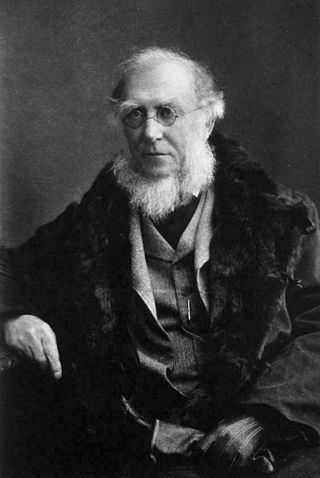
Sir Joseph Dalton Hooker was a British botanist and explorer in the 19th century. He was a founder of geographical botany and Charles Darwin's closest friend. For 20 years he served as director of the Royal Botanical Gardens, Kew, succeeding his father, William Jackson Hooker, and was awarded the highest honours of British science.
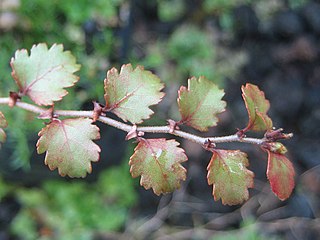
Antarctic flora are a distinct community of vascular plants which evolved millions of years ago on the supercontinent of Gondwana. Presently, species of Antarctica flora reside on several now separated areas of the Southern Hemisphere, including southern South America, southernmost Africa, New Zealand, Australia, and New Caledonia. Joseph Dalton Hooker was the first to notice similarities in the flora and speculated that Antarctica had served as either a source or a transitional point, and that land masses now separated might formerly have been adjacent.

Herpolirion is a genus of perennial herbs in the family Asphodelaceae, subfamily Hemerocallidoideae. The sole species is Herpolirion novae-zelandiae, commonly known as sky lily. It is native to New Zealand as well as the states of New South Wales, Victoria and Tasmania in Australia.

Leptospermum nitidum, commonly known as shiny tea-tree, is a species of compact shrub that is endemic to Tasmania. It has crowded, aromatic, elliptical leaves, white flowers about 15 mm (0.59 in) in diameter and fruit that remain on the plants until it is burned or dies.

The Flora Antarctica, or formally and correctly The Botany of the Antarctic Voyage of H.M. Discovery Ships Erebus and Terror in the years 1839–1843, under the Command of Captain Sir James Clark Ross, is a description of the many plants discovered on the Ross expedition, which visited islands off the coast of the Antarctic continent, with a summary of the expedition itself, written by the British botanist Joseph Dalton Hooker and published in parts between 1844 and 1859 by Reeve Brothers in London. Hooker sailed on HMS Erebus as assistant surgeon.
Caltha appendiculata is a perennial herb plant found in several countries of South America.

Caltha dioneaefolia is a dwarf perennial herb, of the Buttercup Family (Ranunculaceae) with apparently seated pale yellow flowers with about seven stamens and two to three free carpels and leaves that are reminiscent of those of the Venus flytrap, but very small and with leaflike appendages on the leaf. C. dioneaefolia occurs in the southern Andes of Chili and Argentina, including on Tierra del Fuego and Hermite Island.

The Ross expedition was a voyage of scientific exploration of the Antarctic in 1839 to 1843, led by James Clark Ross, with two unusually strong warships, HMS Erebus and HMS Terror. It explored what is now called the Ross Sea and discovered the Ross Ice Shelf. On the expedition, Ross discovered the Transantarctic Mountains and the volcanoes Mount Erebus and Mount Terror, named after each ship. The young botanist Joseph Dalton Hooker made his name on the expedition.
The Flora Novae-Zelandiae is a description of the plants discovered in New Zealand during the Ross expedition written by Joseph Dalton Hooker and published by Reeve Brothers in London between 1853 and 1855. Hooker sailed on HMS Erebus as assistant surgeon. It was the third in a series of four Floras in the Flora Antarctica, the others being the Botany of Lord Auckland's Group and Campbell's Island (1843–45), the Botany of Fuegia, the Falklands, Kerguelen's Land, Etc. (1845–1847), and the Flora Tasmaniae (1853–1859). They were "splendidly" illustrated by Walter Hood Fitch.
The Botany of Fuegia, the Falklands, Kerguelen's Land, Etc. is a description of the plants discovered in these islands during the Ross expedition written by Joseph Dalton Hooker and published by Reeve Brothers in London between 1845 and 1847. Hooker sailed on HMS Erebus as assistant surgeon. It was the second in a series of four Floras in the Flora Antarctica, the others being the Flora of Lord Auckland and Campbell's Islands (1843-1845), the Flora Novae-Zelandiae (1851–1853), and the Flora Tasmaniae (1853–1859). They were "splendidly" illustrated by Walter Hood Fitch.

The Botany of Lord Auckland's Group and Campbell's Island is a description of the plants discovered in those islands during the Ross expedition written by Joseph Dalton Hooker and published by Reeve Brothers in London between 1844 and 1845. Hooker sailed on HMS Erebus as assistant surgeon. It was the first in a series of four Floras in the Flora Antarctica, the others being the Botany of Fuegia, the Falklands, Kerguelen's Land, Etc. (1845–1847), the Flora Novae-Zelandiae (1851–1853), and the Flora Tasmaniae (1853–1859). They were "splendidly" illustrated by Walter Hood Fitch.
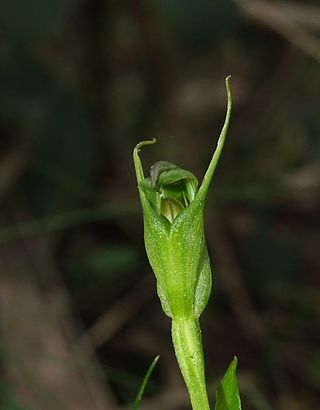
Pterostylis foliata, commonly known as the slender greenhood, is a species of orchid widespread in south-eastern Australia and New Zealand. Flowering plants have a rosette of three to six, dark green, crinkled leaves crowded around the flowering stem and a single dark green and brown flower with a deep V-shaped sinus between the lateral sepals.

Plantago aucklandica is a species of flowering plant in the family Plantaginaceae that is endemic to the subantarctic Auckland Islands, New Zealand. Joseph Dalton Hooker described P. aucklandica in his Flora Antarctica in 1844. Plants of this plantain are large with large leaves, up to seven veins, wide petioles, colliculate seeds, and long spikes with dozens of flowers and one-seeded fruits. This species in considered to be At Risk - Naturally Uncommon, as it is an island endemic with a restricted range.
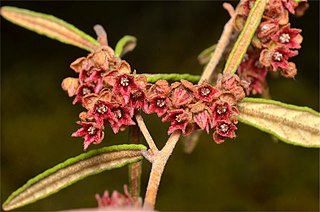
Lasiopetalum micranthum is a species of flowering plant in the family Malvaceae and is endemic to a small region of eastern Tasmania. It is a low, spreading shrub with thin, rusty-hairy branches, narrow oblong leaves and drooping, star-shaped red to greyish-pink or white flowers.
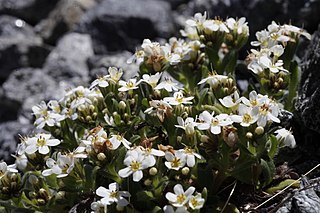
Myosotis lyallii is a species of flowering plant in the family Boraginaceae, endemic to New Zealand. Joseph Dalton Hooker described the species in 1853. Plants of this species of forget-me-not are perennial with a prostrate habit, bracteate or partially-bracteate inflorescences, and white corollas.
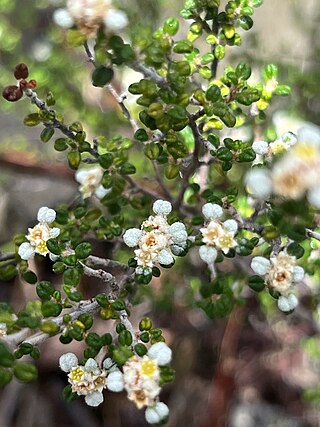
Spyridium lawrencei, commonly known as small-leaf spyridium or small-leaf dustymiller, is a species of flowering plant in the family Rhamnaceae and is endemic to Tasmania. It is an erect, compact or straggling shrub with small, leathery, round to heart-shaped leaves, and dense heads of hairy, cream-coloured flowers.

Cryptandra alpina, commonly known as alpine pearlflower, is a species of flowering plant in the family Rhamnaceae and is endemic to Tasmania. It is a small, prostrate shrub with slender branches, linear leaves, and tube-shaped white flowers arranged singly on the ends of branches.

Spyridium obcordatum, commonly known as creeping spyridium or creeping dustymiller, is a species of flowering plant in the family Rhamnaceae and is endemic to Tasmania. It is a prostrate shrub with heart-shaped leaves, the narrower end towards the base, and clusters of hairy, white flowers.
Puccinellia stricta is a species of grass known by the common names Australian saltmarsh grass, and Marshgrass. It was first described by Joseph Dalton Hooker in 1853 as Glyceria stricta from a specimen collected at Akaroa, but was assigned to the genus, Puccinellia, in 1930 by Carl Hilding Blom. It is native to New Zealand and Australia, where it is found in Western Australia, South Australia, Victoria and Tasmania.
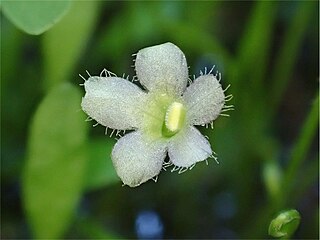
Glossostigma elatinoides, also known as small mud-mat, is a flowering plant in the family Phrymaceae and grows in eastern states of Australia. It is a small aquatic or terrestrial herb with mauve flowers.














